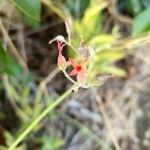Sparsely branched shrublets with erect, terete branches rarely up to 1.2 m high. Leaves petiolate to sessile, glabrous; petiole 0-25 mm long, not clasping; lamina elliptic to oblong-elliptic, rarely ovate or obovate, (20-)30-50 (-75) x (5-)8-25 (-50) mm, acute to rounded, entire, sinuate, dentate, crenate or lobed, flat or slightly concave above, blue-green, rarely yellowish green and usually with a bloom. Inflorescence a sparse, rounded thyrse with several small dichasia. Calyx with lobes narrowly triangular, 0.5-1.5 mm long. Corolla orange to deep red; tube elongate-ampullaceous, 6-10 mm long; lobes lanceolate, 2.5-4 x 1.5-2.5 mm. Anthers 0.6-0.8 mm long. Squamae linear, 2.5-3.5 mm long, gradually tapering towards apices. Seeds c. 1 mm long.
Corolla 10-12(13) mm. long; tube up to 4 mm. in diameter and ovoid to subglobose in the lower 2/3, contracted above the carpels into a narrower cylindrical-tubular portion twisted at fruiting-time, pale glaucous to green at the base, bright pink to scarlet above, turning pale pink to hyaline and bursting easily in fruit; lobes 2·5-4(5) x 1-1·25(1·5) mm., lanceolate to elliptic, subfalcate, very acute (but not apiculate), twisted at the apex, bright pink, orange, salmon to dull red or brick.
Perennial herb, up to 1.2 m high; branches erect, terete. Leaves petiolate to sessile; blade elliptic to oblong-elliptic, 30-50 x 8-25 mm, apex acute to rounded, base cuneate, margin entire or lobed, blue-green. Flowers: inflorescence a sparsely flowered, rounded thyrse; calyx narrowly triangular, 0.5-1.5 mm long; corolla with tube 6-10 mm long, lobes narrowly ovate, 2.5-4.0 mm long, orange to deep red; Mar.-Aug.
Sparse, succulent shrublet, 1-several, erect, terete stems, up to ± 1.2 m high. Leaves petiolate, not clasping, elliptic to oblong, 30-50 x 8-25 mm, acute to rounded, entire or lobed, flat to slightly concave above, blue-green, often with bloom. Inflorescence a sparse, rounded thyrse with several small dichasia. Corolla orange to deep red; tube elongate-ampullaceous, 6-10 mm long. Flowering time Mar.-Aug.
Flowers erect, in usually loose cymes (sometimes reduced to 1-2 flowers), grouped in a corymb-or panicle-like or sometimes thyrsoid inflorescence, usually small (2-14 x 3·5-10 cm.), sometimes attaining 37(38) cm. in length; main branches of inflorescence up to 8 pairs, slender, erect, floriferous only at the extremity, the lower ones up to 27 cm. long; pedicels of dichotomies 2·5-8 mm. long.
Stems 1-(2), usually simple or sometimes with a branch near the base, rarely branched above, 2-5(8) mm. in diameter below, rather slender above, erect, terete, smooth, glaucous, often leafless after anthesis, sometimes several floriferous stems from a prostrate base of a main stem; nodes not or slightly raised.
Leaves ± spreading to erect, at least the lower ones petiolate, condensate towards the base of stem, ± scattered upwards, caducous; lamina 1-5(8·5) x (0·5)0-7-2·5(5·5) cm., usually small, succulent but not very fleshy, rather thin to nearly translucent on drying, pale green to glaucous.
Sparsely branched shrublet with erect, terete branches, up to 1.2 m high. Calyx lobes 0.5-1.5(-2.0) mm long. Leaves with cuneate base, sinuate, margin crenate, dentate or lobed, blue-green. Inflorescence a sparse rounded thyrse. Flowers orange to deep red.
Calyx 1·5-2·5(3) mm. long; sepals 0·8-1 mm. broad at the base, lanceolate or triangular, acute, nearly free, rigid on drying, caducous at fruiting time.
A completely glabrous, 0·2-2 m. high, perennial (or sometimes annual) plant, succulent, sometimes with sterile small-leaved shoots at the base.
Filaments 0·75-1·25 mm. long; anthers 0·3-0·4(0·5) mm., ovate, dark red, included, the upper ones just below the base of the corolla-limb.
Succulent shrublet to 1 m. Leaves opposite, elliptic. Flowers in a rounded cyme, orange to red.
Follicles 4·25-6·75 mm. long, dark red; styles 0·3-0·5 m. long.

